| |
Click on the maps for larger image |
| |
|
| Regional Surface Meteorological Networks |
| |
|
| Union Pacific Railroad Weather Station Network - The Union Pacific Railroad
operates this network of 264 weather stations (5 in Texas) located in the central and western United
States. Further information on Union Pacific is available on their
home page. This network is included as part of the University of Utah
MesoWest and NOAA/Earth
System Research Laboratory (ESRL) Global Systems Division (GSD)
MADIS data sets. |
 . . |
| KFDM WeatherNet
- KFDM-TV in Beaumont, Texas operates this network of 42 stations located
primarily at schools throughout southeastern Texas (41 in Texas). The
network provides up to 1-minute observations of air temperature, relative
humidity, wind speed, wind direction, precipitation, and barometric pressure.
For further information visit the
KFDM
network page. |
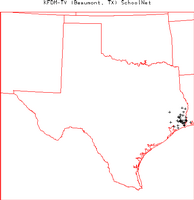 |
| |
|
| KVII WeatherNet
- KVII-TV in Amarillo, Texas operates this network of 54 stations located
primarily at schools throughout the Texas panhandle. The
network provides up to 1-minute observations of air temperature, relative
humidity, wind speed, wind direction, precipitation, and barometric pressure.
For further information visit the
KVII weather page. |
 |
| |
|
| KTSM WeatherNet
- KTSM-TV in El Paso, Texas operates this network of 15 stations located
primarily at schools throughout far western Texas and southeastern New
Mexico (8 in Texas). The
network provides up to 1-minute observations of air temperature, relative
humidity, wind speed, wind direction, precipitation, and barometric pressure.
For further information visit the
KTSM
network page. |
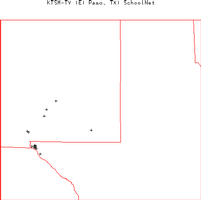 |
| |
|
| KAUZ WeatherNet
- KAUZ-TV in Wichita Falls, Texas operates this network of 6 stations located
primarily at schools throughout northcentral Texas (5 in Oklahoma). The
network provides up to 1-minute observations of air temperature, relative
humidity, wind speed, wind direction, precipitation, and barometric pressure.
For further information visit the
KAUZ
network page. |
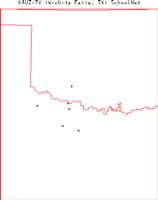 |
| |
|
| State and Local Surface Meteorological Networks |
| |
|
| Texas Mesonet - Texas A&M University and Texas Tech University
oversee this network. For further information visit the
Texas Mesonet page. |
No Map. |
| West Texas Mesonet - Texas Tech University
operates this network of 34 stations in the area around Lubbock, Texas. The
network provides 5-minute observations of air temperature, wind speed, wind
direction, relative humidity, barometric pressure, precipitation, solar radiation,
soil temperature (at 5, 10 and 20 cm depths), soil moisture (at 5, 20, 60 and 75 cm
depths) and leaf wetness. For further information visit the
West Texas Mesonet home
page. Meteogram imagery for the West Texas Mesonet is available from the
University of Oklahoma. |
 |
| |
|
| Texas North Plains Evapotranspiration (ET)
Network - The Texas A&M University Agricultural Research and Extension
Center operates this network of 15 stations throughout the Texas Panhandle region.
The network provides hourly observations of solar radiation, soil temperature at 2
and 6 inch depths), air temperature, dew point, relative humidity, vapor pressure,
vapor pressure deficit, wind speed, wind direction, precipitation and barometric
pressure. For further information visit the Texas North Plains ET Network home
page at:
http://amarillo2.tamu.edu/nppet/petnet1.htm. |
 |
| |
|
| Texas North Plains Weather Network - Texas
North Plains Weather Network
|
| |
|
| Texas Central Plains Weather Network - Texas
Central Plains Weather Network
|
| |
|
| Texas South Plains ET Network - No information
at present. For further information visit the
Texas South Plains ET Network. |
No map. |
| |
|
| Texas Evapotranspiration Network -
The Agriculture Program of the Texas A&M University System operates this network
of 24 stations throughout the state of Texas. The network provides hourly
observations of air temperature, relative humidity, solar radiation, wind speed,
and precipitation. For further information visit the
Texas ET Network. |
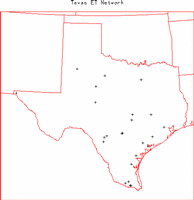 |
| |
|
| Road Weather Information System (RWIS) - The Texas Department
of Transportation (DOT) operates this network of 12 stations located throughout
the state of Texas. The network provides variable temporal resolution observations
of air temperature, relative humidity, dew point, wind speed, wind direction, visibility,
and precipitation (yes/no). For further information visit the
Surface Systems, Inc Road
Weather page. |
Map at Web Site |
| |
|
| City of Dallas ALERT Weather Station Network -
The City of Dallas, Texas operates this network of 5 weather stations in and
around the city of Dallas. The network provides up to 1-minute observations of
air temperature, relative humidity, barometric pressure, wind speed, and wind
direction. For further information visit the
City of
Dallas Flood Control District. |
 |
| |
|
| Harris County ALERT Weather Station Network - The Harris County
Office of Emergency Management operates this network of 18 weather stations with
locations throughout Harris County (Houston) Texas. The parameters vary by station,
but include air temperature, relative humidity, wind speed, wind direction, and
precipitation. For further information visit the
Harris
County ALERT page. |
No map. |
| |
|
| Lower Colorado River Authority (LCRA) Weather Station
Network - The LCRA operates this network of 158 stations with locations along
the lower Colorado River in Texas. The network provides hourly observations of air
temperature, relative humidity, precipitation, and streamflow. For further
information visit the
LCRA River
Data page. |
No map. |
| |
|
| Texas Natural Resources Conservation Commission (TNRCC)
Air Monitoring Network - The TNRCC monitors air quality across the state of
Texas with this network of 131 stations operated by various local agencies. The network
provides hourly observations of a varying set of parameters typically including air
temperature, wind speed, and wind direction. For further information visit the
TNRCC
Air Monitoring page. |
 |
| |
|
| WOAI WeatherNet
- WOAI-TV in San Antonio, Texas operates this network of 41 stations located
primarily at schools throughout Texas. The
network provides up to 1-minute observations of air temperature, relative
humidity, wind speed, wind direction, precipitation, and barometric pressure.
For further information visit the
WOAI network page. |
No map yet. |
| |
|
| KPRC WeatherNet
- KPRC-TV in Houston, Texas operates this network of 90 stations located
primarily at schools throughout southeastern Texas. The
network provides up to 1-minute observations of air temperature, relative
humidity, wind speed, wind direction, precipitation, and barometric pressure.
For further information visit the
KPRC
network page. |
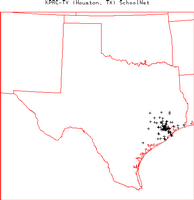 |
| |
|
| KXAS WeatherNet
- KXAS-TV in Dallas/Fort Worth, Texas operates this network of 131 stations located
primarily at schools throughout northcentral Texas. The
network provides up to 1-minute observations of air temperature, relative
humidity, wind speed, wind direction, precipitation, and barometric pressure.
For further information visit the
KXAS
network page. |
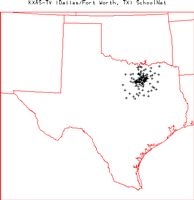 |
| |
|
| KXTX WeatherNet
- KXTX-TV in Dallas, Texas operates this network of 191 stations located
primarily at schools throughout northcentral Texas. The
network provides up to 1-minute observations of air temperature, relative
humidity, wind speed, wind direction, precipitation, and barometric pressure.
For further information visit the
KXTX
network page. |
No map yet. |
| |
|
| KWTX WeatherNet
- KWTX-TV in Waco, Texas operates this network of 38 stations located
primarily at schools throughout central Texas. The
network provides up to 1-minute observations of air temperature, relative
humidity, wind speed, wind direction, precipitation, and barometric pressure.
For further information visit the
KWTX
network page. |
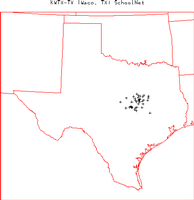 |
| |
|
| KXAN WeatherNet
- KXAN-TV in Austin, Texas operates this network of 75 stations located
primarily at schools throughout central Texas. The
network provides up to 1-minute observations of air temperature, relative
humidity, wind speed, wind direction, precipitation, and barometric pressure.
For further information visit the
KXAN
network page. |
 |
| |
|
| KMOL WeatherNet
- KMOL-TV in San Antonio, Texas operates this network of 35 stations located
primarily at schools throughout southcentral Texas. The
network provides up to 1-minute observations of air temperature, relative
humidity, wind speed, wind direction, precipitation, and barometric pressure.
For further information visit the
KMOL
network page. |
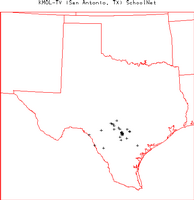 |
| |
|
| KTXS WeatherNet
- KTXS-TV in Abilene, Texas operates this network of 23 stations located
primarily at schools throughout central Texas. The
network provides up to 1-minute observations of air temperature, relative
humidity, wind speed, wind direction, precipitation, and barometric pressure.
For further information visit the
KTXS weather page. |
 |
| |
|
| KVIA WeatherNet
- KVIA-TV in El Paso, Texas operates this network of 9 stations located
primarily at schools throughout central Texas. The
network provides up to 1-minute observations of air temperature, relative
humidity, wind speed, wind direction, precipitation, and barometric pressure.
For further information visit the
KVIA home page. |
 |
| |
|
| KLTV WeatherNet
- KLTV-TV in Tyler, Texas operates this network of 29 stations located
primarily at schools throughout northeastern Texas. The
network provides up to 1-minute observations of air temperature, relative
humidity, wind speed, wind direction, precipitation, and barometric pressure.
For further information visit the
KLTV
network page. |
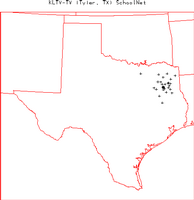 |
| KAVU WeatherNet
- KAVU-TV in Victoria, Texas operates this network of 6 stations located
primarily at schools throughout Texas. The
network provides up to 1-minute observations of air temperature, relative
humidity, wind speed, wind direction, precipitation, and barometric pressure.
For further information visit the
KAVU network page. |
No map yet. |
| |
|
| Precipitation and Radar Networks |
|
|
| Community Collaborative Rain, Hail and Snow Network (CoCoRaHS) - The Colorado
Climate Center at Colorado State University overseas this cooperative network of observers
located throughout Texas. The network provides daily observations of
precipitation, snowfall, and snow depth. Hailpad observations are also made at many
locations. For further information visit the
CoCoRaHS home page. |
No map. |
| |
|
| NOAA/National Centers for Environmental
Prediction (NCEP) Hourly Precipitation Data - NOAA/NCEP routinely develops
a National Multi-sensor Hourly Precipitation Analysis (Stage II) data set from
hourly radar precipitation estimates and from hourly gage reports. The gage data
includes hourly observations from ~4000 gages across the US (303 in Texas)
collected by the NOAA River Forecast Centers and sent to NCEP. Further information
on these data is available at:
http://wwwt.emc.ncep.noaa.gov/mmb/ylin/pcpanl/. |
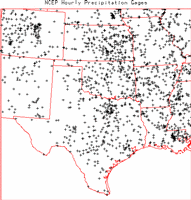 |
| |
|
| NOAA/NWS Cooperative Observer 15-minute Precipitation Network - The
NOAA/NWS
routinely collects 15-minute observations of precipitation from Fisher-Porter and Universal
rain gages operated by 2777 cooperative observers located throughout the US (210 in Texas).
These data are archived at NOAA/National Climatic Data Center (NCDC) as data set TD 3260.
For further information visit the NOAA/NCDC TD3260 page at:
http://ols.nndc.noaa.gov/plolstore/plsql/olstore.prodspecific?prodnum=C00505-TAP-A0001 |
 |
| |
|
| Harris County ALERT Precipitation Network -
Harris County, Texas operates this network of 177 precipitation gages throughout
its County (Houston area). The network provides up to 1-minute observations of
precipitation. For further information visit the
Harris
County ALERT page. |
 |
| |
|
| City of Dallas ALERT Precipitation Network -
The City of Dallas, Texas operates this network of 58 precipitation gages in and
around the city of Dallas. The network provides up to 1-minute observations of
precipitation. For further information visit the
City of
Dallas Flood Control District. |
 |
| |
|
| City of Austin ALERT Network - City
of Austin ALERT Network
|
| |
|
| Jefferson County Drainage District 6 ALERT
Precipitation and Stream Level Network - Jefferson County (Texas) Drainage
District 6 operates this network of 42 precipitation and stream level gages throughout
Jefferson County in the far southeastern corner of Texas. The network provides
up to 1-min observations of precipitation and water level. For further information
visit the Jefferson County Drainage
District 6 page. |
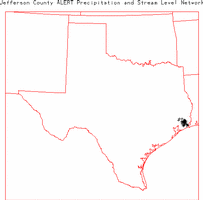 |
| |
|
| Edwards Aquifer Authority Network -
Edwards Aquifer Authority Precipitation and Water Network
|
| |
|
| Weather Surveillance Radar 1988 Doppler (WSR-88D)
Network - The NOAA/NWS and the Department of Defense operate this network
of 143 WSR-88D radars across the contiguous US (12 in Texas). The Level II
data are the three meteorological base data quantities (reflectivity, mean radial
velocity, and spectrum width) and are recorded at all NWS and most DOD sites.
Level II data are then processed in order to create a number of meteorological analysis
products known as Level III data. Level III data are recorded at the NWS sites. The
Level III products included base reflectivity, base spectrum width, base velocity,
composite reflectivity, echo tops, velocity azimuth display (VAD) wind profile,
vertically integrated liquid (VIL), 1-hour precipitation, storm total precipitation,
hail index overlay, mesocyclone overlay, severe weather probability overlay, storm
structure, storm tracking information overlay, and tornadic vortex signature overlay.
All Level II and III data are archived at NOAA/NCDC. For further information visit
the NOAA/NCDC Radar Resources page at:
http://www.ncdc.noaa.gov/oa/radar/radarresources.html or the NOAA Radar
Operations Center at:
http://www.roc.noaa.gov/. |
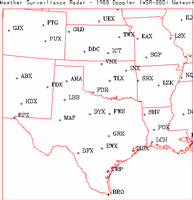 |
| |
|
| Radiation and Flux Networks |
| |
|
| Cooperative Network for Renewable Resource
Measurements (CONFRRM) Network - The National Renewable Energy Laboratory
(NREL) oversees this network of 11 radiation stations (4 in Texas) with
locations primarily in the southern and eastern US. The network provides 5-minute
observations of global horizontal irradiance, direct normal irradiance, and diffuse
horizontal irradiance. Some of the sites also provide various surface meteorological
parameters. For further information visit the CONFRRM home page at:
http://rredc.nrel.gov/solar/new_data/confrrm/. |
 |
| |
|
| United States Department of Agriculture (USDA)
UV-B Monitoring Network - The USDA operates this network of 29 stations
with locations throughout the US (1 in Texas). The network provides
3-minute observations of spectral total/direct/diffuse radiation, air temperature,
relative humidity, solar radiation, barometric pressure, and photosynthetically
active radiation. For further information visit the
USDA UV-B Monitoring page. |
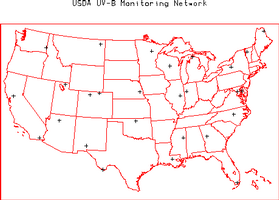 |
| |
|
| Soil Networks |
| |
|
| Soil Climate Analysis Network (SCAN) - The SCAN is operated by the United
States Department of Agriculture (USDA) Natural Resources Conservation Service (NRCS). The
network provides hourly observations of air temperature, relative humidity, wind speed,
wind direction, solar radiation, precipitation, barometric pressure, snow water content,
snow depth, soil temperature (at 2, 4, 8, 20, and 40 cm depths), and soil moisture (at 2, 4,
8, 20 and 40 cm depths). The 80 SCAN stations are located across the US in primarily
agricultural regions (2 in Texas). For further information visit the
SCAN home page. |
 |
| |
|
| Hydrology Networks |
| |
|
| United States Geological Survey (USGS) Streamflow
Network - The USGS (part of the US Department of the Interior) operates this
network of 7237 streamflow gages (446 in Texas) at locations throughout the US.
The network provides hourly or more frequent observations of stage (water level) from
which discharge (flow) is computed using a stage-discharge rating relation. The
rating is defined by occasional direct current-meter measurements of discharge. All
data are available through the USGS and the district offices in each state. Many of
these gages provide realtime data
relayed via the GOES satellite data collection system. The realtime data are
provisional data that have not been reviewed or edited. These realtime data
may be subject to significant change and are not citeable until reviewed and approved
by the USGS. Realtime data may be changed after review because the stage-discharge
relationship may have been affected by: 1) backwater from ice or debris; 2) algal and
aquatic growth in the stream; 3) sediment movement; and 4) malfunction of recording
equipment. Each station record is considered provisional until the data are
published. The data are usually published with 6 months of the end of the water year
(1 October to 30 September). Data users are cautioned to consider carefully the
provisional nature of the information before using it. For further information on the
USGS streamflow network visit the USGS Water Resources of the United States page at:
http://water.usgs.gov/ or the
USGS Texas District Office home page at:
http://tx.usgs.gov/. |
 |
| |
|
| USDA/ARS Watershed Research - The USDA/ARS operates a number of
research watersheds throughout the US. Some of the best instrumented include the
Reynolds Creek in Idaho, the Walnut Gulch in Arizona, the Southern Plains
Experimental Range in Oklahoma, the Little Washita River in Oklahoma, the Blackland
Prairie in Texas, the Goodwater Creek in Missouri, the Walnut Creek in Iowa,
Goodwin Creek in Mississippi, the Little River in Georgia, the Oconee River in
Georgia, the North Appalachian Watershed in Ohio, the National Agriculture Research
Center in Maryland, and the Mahantango Creek in Pennsylvania. Most of these have at
least one surface meteorological station and a precipitation gage network. For
further information visit the USDA/ARS Watershed Research home page at:
http:/www.nwrc.ars.usda.gov/watershed/. |
 |
| |
|
| Harris County ALERT Stream Level Network -
Harris County, Texas operates this network of 137 stream level gages throughout
its County (Houston area). The network provides up to 1-minute observations of
stream level. For further information visit the
Harris
County ALERT page. |
 |
| |
|
| City of Dallas ALERT Stream Level Network -
The City of Dallas, Texas operates this network of 61 stream level gages in and
around the city of Dallas. The network provides up to 1-minute observations of
stream level. For further information visit the
City of
Dallas Flood Control District. |
 |
| |
|
| Upper Air Networks |
| |
|
| NOAA/NWS Radiosonde Network Low Vertical Resolution Data - The NOAA/NWS
typically releases radiosondes twice per day at 0000 and 1200 UTC at 69 locations throughout
the US (7 in Texas). During special weather situations the NWS can request to release
additional radiosondes at off-times (e.g. 1800 UTC). The low resolution data is sent out
over the Global Telecommunications System (GTS) and provides mandatory and significant level
observations of pressure, altitude, temperature, dew point, wind speed, and wind direction.
There are 3 types of radiosondes utilized within the US network, Vaisala, VIZ (or Sippican),
and Microsonde. These data are archived by NOAA/NCDC and other organizations. For further
information on the NWS Radiosonde network visit the
NWS Upper-air Observations Program
home page. A several year archive of GTS upper air data is available at the
NOAA/FSL Radiosonde Database. |
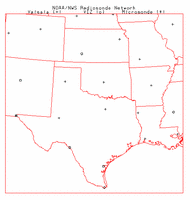 |
| |
|
| NOAA/NWS Radiosonde Network High Vertical Resolution Data - The same
radiosonde locations mentioned in the previous data set also provide a 6-second vertical
resolution data set that provides observations of pressure, temperature, altitude,
relative humidity, and azimuth and elevation angles. UCAR/JOSS has developed software
to derive 6-second vertical resolution winds from the angle data. These data are
archived by NCDC and UCAR/JOSS. |
 |
| |
|
| NOAA Profiler Network (NPN) - The NOAA/Forecast Systems Laboratory
(FSL) operates this network of 32 404 MHz wind profilers primarily across the central
portion of the United States (3 in Texas). Each site provides 6-minute and hourly
vertical profiles of wind speed and wind direction. Additionally, 11 of the NPN
sites have a collocated Radio Acoustic Sounding System (RASS) that provides 6-minute
and hourly vertical profiles of virtual temperature (2 in Texas). For further
information visit the
NPN home page.
An archive of the hourly wind profiles is available from
NCAR/SCD. |
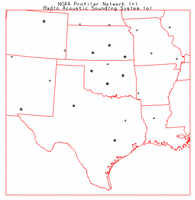 |
| |
|
| Cooperative Agency Profiler (CAP) Network - The NOAA/FSL ingests data
from wind profilers and RASS operated by a number of cooperating agencies. Most of
these profilers are 915 MHz, but some are 449 or 50 MHz. Most provide hourly observations
of wind speed and direction. The number and location of these can vary through time. As
this is being written the network included 58 locations within the US (2 in Texas).
Most of the sites are along the US West Coast and in the northeastern US. For further
information visit the CAP home page at:
http://www.profiler.noaa.gov/jsp/aboutCap.jsp. |
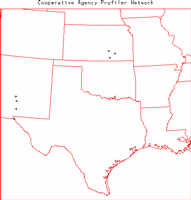 |
| |
|
| Ground Based Global Positioning System (GPS) Meteorology Demonstration Network
(GPS-MET) - The NOAA/FSL ingests data from 323 GPS locations around the US
operated by many different agencies (25 in Texas). Typically each location provides
30-minute observations of integrated precipitatable water along with a number of surface
meteorology parameters (air temperature, relative humidity, barometric pressure, etc).
For further information visit the
GPS-MET home page. |
 |
| |
|
| Aerosol Networks |
| |
|
| None known at this time.
| |
| |
|
| Coastal Networks |
| |
|
| Coastal-Marine Automated Network (C-MAN) -
The National Data Buoy Center (NDBC) operates this network of 55 C-MAN stations
with locations along coastlines throughout the US (2 in Texas). The network
typically provides hourly observations of air temperature, barometric pressure,
wind speed, wind direction, and wind gust. Some stations also provide
observations of sea water temperature, water level, waves, relative humidity,
precipitation, and visibility. For further information visit the
NDBC home page. |
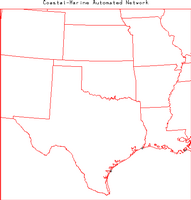 |
| |
|
| National Data Buoy Center (NDBC) Moored Buoy
Network - The NDBC operates this network of 77 moored buoys with locations
throughout the US coastal regions (3 off the coast of Texas). The network typically
provides hourly observations of air temperature, dew point, water temperature,
barometric pressure, wind speed, wind direction, wave height, wave period, and
swell. For further information visit the
NDBC home page. |
 |
| |
|
| National Water Level Observation Network (NWLON) - The National
Ocean Service (NOS) Center for Operational Oceanographic Products and Services (CO-OPS)
maintains a long-term database containing water-level
measurements and derived tidal data. NWLON provides water level observations at 318
locations throughout the United States. Some stations provide additional measurements
including air and water temperature, pressure and winds. For additional information
visit the NWLON web page. |
 |
| |
|
| Gulf of Mexico Coastal Ocean Observing System (GCOOS) -
Seeks to establish a sustained observing system for the Gulf of Mexico to provide observations and products
needed by users in the Gulf of Mexico region. For further information on GCOOS visit the
GCOOS home page. |
|
| |
|
| Texas Automated Buoy System (TABS) - Texas A&M
University Geochemical and Environmental Research Group operates this network of
9 buoys located off of the Texas coast. The network provides hourly observations
of air temperature, wind speed, wind direction, and wind gust. For further
information visit the TABS
home page. |
 |
| |
|
| Texas Coastal Ocean Observation Network (TCOON) - The Conrad
Blucher Institute for Surveying and Science (CBI) at Texas A&M University-Corpus
Christi started this water level measurement system along the Texas coast in 1989.
The network includes a total of 37 stations located along the Texas coastline.
All stations within the network provide hourly observations of water level.
Additionally 27 of the stations provide hourly observations of at least one
meteorological parameter (air temperature, barometric pressure, wind speed, wind
gust and/or wind direction. For futher information visit the
TCOON home
page. |
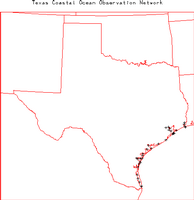 |
 .
.







































 .
.






































